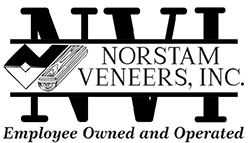Norstam's Veneer Process
In most industries, a leader helps to set the stage for others to follow. Quality, availability, and price are important to all of our customers. At Norstam, we accept the responsibility and challenge to meet our customers ever-changing needs in the marketplace. Our commitment to this philosophy is serious business. Our leadership role in the industry, utilization of modern technology, and outstanding customer service enables NVI to make the difference.
Log Yard

The log yard is the first stop for logs arriving at our facility. Once they are unloaded, logs are sorted by species and it is determined whether the log is to be sawn into lumber or veneer.
Debarking

Once a log has been selected by our yard crew, it is delivered to our debarking station. Here the bark is removed along with any dirt or rocks that is on the outside of the log. This is done to protect the head saw from dulling or damage.
Sawmill

Once into the sawmill, the sawyer examines each log carefully and makes a determination how the log is to be sawn. At this point, the final decision is made to produce lumber or veneer. If the log is to be made into veneer, it may be cut into two halves (flitches) or into several sections, depending upon the best utilization of each log.
Cooking

From the sawmill, several flitches of like species are bundled together and are cooked in giant vats. Different species of wood have unique characteristics, so the recipes for cooking differ from one to the other. The length of time and the temperature that the wood is cooked at, determines how light or dark the wood is and also softens the wood for slicing. After years of experience, NVI has developed just the right formulas to insure a high quality product.
Veneer Slicing

After the flitches have completed the cooking process, each one is planed down to remove any dirt or residue, and is now ready for slicing. A computerized slicer allows for precise and instantaneous adjustments, even in mid-run. Here at Norstam, we have two different types of slicers, a vertical slicer and a rotary slicer. We are able to slice our veneers in a variety of thicknesses, depending upon the job application or customer requirements.
Veneer Drying

The veneer is then dried in our vacuum-fed press dryer. After the veneer is dried, it is crated and placed in our domestic warehouse, or is forwarded onto our trim line.
Veneer Trimline

Not only is quality and well manufactured veneer important, it’s also important to provide accurately measured veneer for our clipped and bundled program. The Frost-Byte Measuring System provides accurate measurements on a consistent basis. Each bundle is clearly labeled with the dimensions and square measurements.
Custom Clipping

Here at NVI, we try to meet the needs of our customers. This includes having the ability to provide a cut-to-size product. We can cut to length and provide an accurate parallel width cut to meet the requirements of the face industry.
Shipping

We insure that all veneer that leaves our facility is packaged and shipped effectively in order to reduce the risk of damage. We offer palletized or unitized flitches, whichever is preferred. Also, in order to cater to the needs of our customers, we can stencil identification codes on different parcels of veneer within any shipment to allow easier access once it’s received. Whether we arrange a truck, or our customers are arranging transportation, our loading docks are capable of handling LTL box carriers, flatbeds, or dropped off containers.

